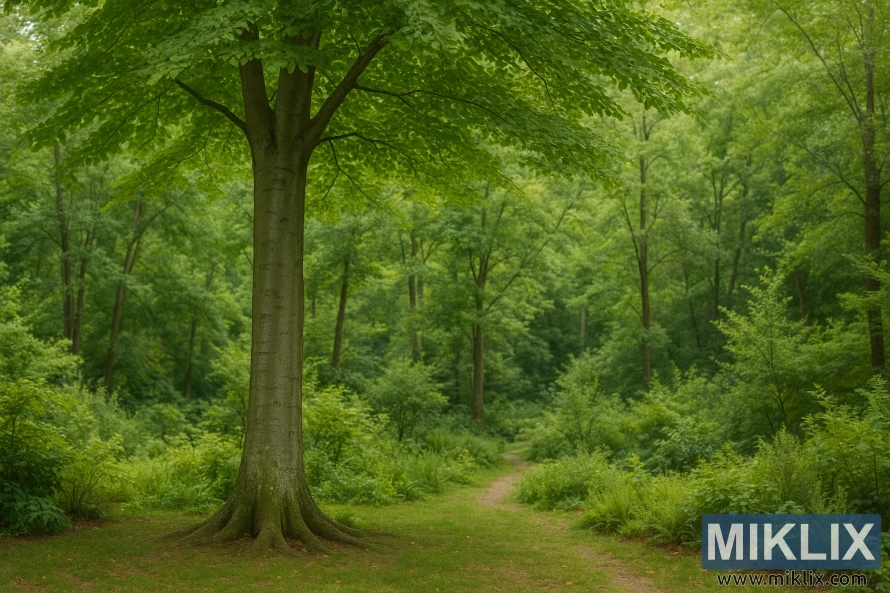Image: American Beech Tree
Published: August 28, 2025 at 10:13:39 AM UTC
Last updated: September 28, 2025 at 8:33:02 AM UTC
A majestic American Beech with gray bark, broad green canopy, and flaring roots stands by a woodland path, offering shade and natural beauty.
In this serene woodland setting, a majestic American Beech (Fagus grandifolia) takes its place as both guardian and centerpiece of the landscape, embodying the quiet grandeur for which the species is so well known. Its tall, straight trunk rises with remarkable smoothness, cloaked in silver-gray bark that appears almost polished, free of fissures and rough textures. This bark, often described as one of the defining features of the American Beech, catches the soft woodland light in subtle gradients, creating a living column of understated elegance. At the base, wide, flaring roots spread outward with a sculptural grace, anchoring the tree firmly to the earth while giving the impression of age, permanence, and resilience.
Above, the tree’s expansive canopy spreads in a generous dome of lush green leaves. Each leaf, broad and delicately serrated, contributes to the dense covering of foliage that transforms the light filtering through into a soft, dappled glow. Standing beneath this canopy would be like entering a natural hall, the leaves forming a vaulted ceiling of living green. The air beneath feels cooler, the light subdued, as if the tree itself creates a microclimate of calm and shelter. In summer, this canopy is at its fullest, a vibrant green that radiates vitality and anchors the rhythm of the seasons.
The setting enhances the tree’s presence, situating it along the edge of a winding woodland path that disappears gently into the distance. The path, narrow and slightly worn, suggests quiet walks and moments of reflection, inviting the viewer to step into the scene and follow its meandering course deeper into the forest. Along its sides, ferns and native understory plants thrive in the dappled light, their feathery fronds and varied textures adding richness to the ground layer of the composition. Together, the tree, path, and understory form a layered tableau that feels both wild and orderly, a natural harmony that balances structure with softness.
The background extends the sense of continuity, with more beech and companion hardwoods rising in tall, slender forms throughout the woodland. Their canopies intermingle high above, creating an unbroken expanse of green that stretches into the horizon. The repetition of vertical trunks provides rhythm, while the dense foliage imparts depth and mystery. This backdrop frames the foreground beech, allowing it to stand out without isolation, a leader among its peers yet part of a larger community of trees.
The American Beech’s appeal extends well beyond the summer season depicted here. In autumn, its foliage transforms into a brilliant display of golden bronze, casting the forest in warm, glowing light. Even after the leaves fade, many persist on the branches through winter, their papery forms rattling softly in the wind, offering both sound and texture to the otherwise bare landscape. In spring, tender new leaves emerge in pale green, adding freshness to the woodland’s awakening. Year-round, the smooth bark provides visual interest, especially in the winter when snow and frost emphasize the elegance of the trunk and branches.
This tree is more than just an ornamental specimen—it is a cornerstone of North American woodland ecology. Its nuts, known as beechnuts, provide food for countless species of birds and mammals, while its shade creates cool habitats for understory plants and wildlife alike. Its longevity ensures that it becomes not only a fixture in the garden or forest but a part of the landscape’s living history, a witness to generations passing beneath its branches.
Ultimately, this image captures the American Beech not merely as a tree, but as an emblem of permanence, beauty, and sanctuary within the woodland. Its smooth gray trunk, expansive canopy, and grounded presence embody the qualities that make it one of the most treasured native trees in North America. In a naturalistic garden design or within its native forest home, it offers shade, structure, and a timeless elegance that connects people and place through the quiet power of living form.
The image is related to: Best Beech Trees for Gardens: Finding Your Perfect Specimen

